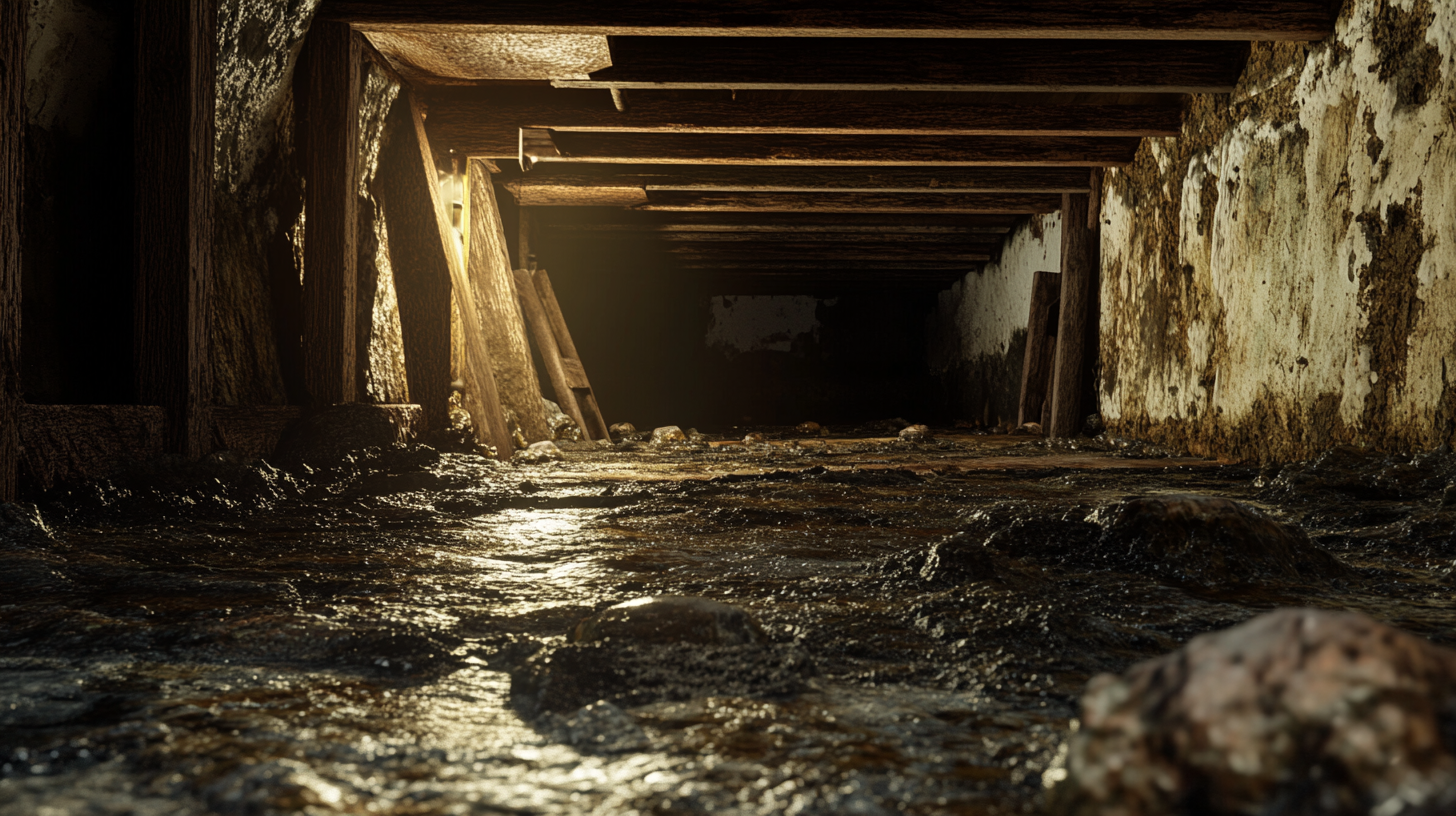Now IS THe Time To...

Crawl Space Services In Knoxville, TN
Stetson Howard: 865-432-6743
CRAWL SPACE ENCAPSULATION, REPAIR, WATERPROOFING & MOLD REMOVAL
No-Obligation, Free Inspections
No-Obligation Free Estimates
We Warranty All of Our Work
100% Satisfaction Guaranteed
As environmental conditions become more unpredictable and the demands of modern construction continue to evolve, the need for innovative waterproofing materials has never been greater. Buildings are now exposed to more extreme weather conditions, from intense rainfall and flooding to rising humidity levels, putting traditional waterproofing methods to the test. At the same time, sustainability concerns are pushing the industry to develop eco-friendly materials that minimize environmental impact while offering superior performance.
In response, the waterproofing industry is innovating with new materials and technologies designed to address both the growing environmental challenges and the complex needs of modern construction. These advancements not only offer enhanced durability and flexibility but also prioritize energy efficiency and sustainability. In this blog, we’ll explore how these evolving demands are shaping the future of waterproofing materials, driving innovations that protect structures while adapting to the changing world around us.
The Evolving Needs for Waterproofing Solutions
As both environmental conditions and construction requirements become more complex, the need for advanced waterproofing solutions has never been more critical. Waterproofing technologies are evolving to meet the growing demands of modern construction, sustainability goals, and extreme climate challenges. Below, we explore the key factors driving this evolution and how different industries are responding with innovative waterproofing solutions.
Changing Environmental and Climatic Conditions
Climate Change: The impacts of climate change, such as increased rainfall, rising water tables, and extreme weather events, are putting immense pressure on traditional waterproofing systems. More frequent and intense rainfall demands waterproofing solutions that can provide superior water resistance, while rising water levels increase the risk of flooding in both residential and commercial spaces. In response, waterproofing materials are being developed with enhanced durability and the ability to withstand prolonged exposure to water and moisture.
Urbanization: Rapid urban development is driving the need for waterproofing materials that perform at a high level while being environmentally responsible. With cities expanding at unprecedented rates, the demand for waterproofing solutions that can protect high-density urban structures from water damage has risen sharply. At the same time, urban environments require solutions that support sustainability initiatives, ensuring that waterproofing materials not only protect but also contribute to energy-efficient and environmentally friendly designs.
Sustainability Goals: The global push for greener construction practices has significantly influenced the innovation of waterproofing materials. The construction industry is moving toward eco-friendly solutions that reduce carbon footprints while providing excellent protection against moisture and water damage. Materials such as recyclable membranes and low-VOC liquid-applied coatings are examples of how waterproofing products are adapting to meet the dual demands of performance and environmental sustainability.
Industry-Specific Waterproofing Demands
Residential and Commercial Buildings: In residential and commercial construction, waterproofing needs are evolving to address long-term durability, energy efficiency, and adaptability to modern architectural designs. Homes and office buildings require waterproofing solutions that not only protect against water infiltration but also integrate with other building systems, such as HVAC and insulation, to enhance energy efficiency. New waterproofing technologies, such as smart membranes that regulate humidity and temperature, are emerging to meet these diverse needs.
Infrastructure Projects: Large-scale infrastructure projects, such as bridges, tunnels, and underground structures, face unique waterproofing challenges due to their exposure to intense water pressure and extreme environmental conditions. For these projects, waterproofing materials must offer exceptional strength and resilience. Innovations in waterproofing for infrastructure include high-performance bituminous membranes and polyurethane coatings designed to withstand harsh conditions while providing long-lasting protection.
Green and Sustainable Building Designs: As more buildings incorporate sustainable design features like green roofs, rainwater harvesting systems, and energy-efficient facades, the need for advanced waterproofing materials becomes even more critical. Green roofs, for example, require waterproofing systems that not only prevent leaks but also support plant growth and proper drainage. In response, the industry is developing solutions that integrate waterproofing with sustainability, such as root-resistant membranes and vapor-permeable barriers that allow structures to remain energy-efficient while protecting against moisture damage.
Key Innovations in Waterproofing Material Technology
As construction demands evolve and environmental challenges intensify, waterproofing technologies are advancing to provide more effective, durable, and sustainable solutions. From self-healing materials to nanotechnology-enhanced coatings, these innovations are shaping the future of waterproofing, offering enhanced protection, longevity, and environmental benefits. Below, we explore some of the most exciting innovations in waterproofing material technology.
Self-Healing Waterproofing Materials
Description: Self-healing waterproofing materials are embedded with microcapsules or special polymers that automatically repair cracks and minor damages. These materials can self-activate when exposed to water, sealing small leaks without external intervention.
Key Benefits:
- Extended lifespan: By sealing small cracks and leaks automatically, self-healing materials help extend the life of waterproofing systems, reducing the need for frequent maintenance.
- Reduced maintenance: These materials minimize the need for manual inspections and repairs, offering long-term reliability and lowering the cost of upkeep.
- Increased durability: Self-healing properties make these materials highly durable, especially in environments exposed to constant water pressure or mechanical stress.
Ideal Applications: Best suited for below-grade waterproofing, tunnels, and critical infrastructure projects like dams and subways, where high water pressure and the risk of water infiltration are constant challenges.
Nanotechnology-Enhanced Waterproofing Coatings
Description: Nanotechnology-enhanced waterproofing coatings use nanoscale particles to create an ultra-thin, water-repellent barrier at the molecular level. These coatings provide superior hydrophobic properties, preventing water from penetrating surfaces.
Key Benefits:
- Superior water repellence: Nano-coatings form a highly hydrophobic surface, drastically reducing water absorption and protecting against moisture penetration.
- Lightweight and easy to apply: These coatings are lightweight and versatile, making them easy to apply on various surfaces, from concrete to metal.
- Resistance to UV and chemicals: Nanotechnology coatings offer increased resistance to UV radiation, chemical exposure, and environmental wear, making them highly durable in harsh conditions.
Ideal Applications: Ideal for roofs, façades, and high-traffic areas exposed to water and varying weather conditions, ensuring long-term protection in both residential and commercial settings.
Green and Sustainable Waterproofing Materials
Description: Green waterproofing materials are made from sustainable, non-toxic, and eco-friendly resources. These materials are designed to minimize environmental impact while providing effective waterproofing solutions.
Key Benefits:
- Environmental sustainability: Using recyclable or biodegradable materials helps reduce the carbon footprint of construction projects and supports eco-friendly building practices.
- Supports LEED certification: These materials contribute to achieving LEED and other green building certifications, making them a top choice for sustainable construction.
- Energy efficiency: Many green waterproofing materials also improve building energy efficiency by reducing heat absorption and enhancing insulation, contributing to overall sustainability.
Ideal Applications: Suitable for green roofs, eco-friendly commercial buildings, and sustainable urban infrastructure projects that prioritize environmental responsibility alongside functional waterproofing.
Smart Waterproofing Membranes
Description: Smart waterproofing membranes are embedded with sensors that monitor the integrity of the waterproofing layer, detecting leaks and moisture levels in real-time. These systems offer an innovative approach to proactive waterproofing maintenance.
Key Benefits:
- Real-time monitoring: Sensors continuously track moisture levels, alerting building managers to potential leaks early, allowing for swift action before significant damage occurs.
- Reduced manual inspections: Smart membranes eliminate the need for frequent manual inspections, optimizing maintenance schedules and reducing overall maintenance costs.
- Critical infrastructure protection: These systems are invaluable for infrastructure where early leak detection is essential to avoid costly repairs or structural damage.
Ideal Applications: Best suited for large infrastructure projects, underground structures, and critical commercial areas where continuous monitoring and early detection are vital for preventing water damage.
Breathable Waterproofing Solutions
Description: Breathable waterproofing membranes and coatings allow moisture vapor to escape from a structure while preventing liquid water from entering. These innovative solutions are perfect for environments that require moisture control without compromising waterproofing integrity.
Key Benefits:
- Moisture control: Breathable membranes allow excess moisture to escape, which is especially important in humid environments to prevent mold and mildew growth.
- Enhanced indoor air quality: By controlling moisture vapor, these materials contribute to better indoor air quality, preventing the buildup of dampness and odors.
- Adaptable to climate conditions: Breathable waterproofing is ideal for regions with high humidity and frequent temperature fluctuations, providing both waterproofing and vapor regulation.
Ideal Applications: Best for bathrooms, basements, and interior walls in areas with high humidity or fluctuating temperatures, ensuring both waterproof protection and breathable moisture management.
Advanced Manufacturing Techniques for Waterproofing Materials
As the construction industry advances, innovative manufacturing techniques are being developed to improve the efficiency, precision, and sustainability of waterproofing materials. These methods not only enhance the performance of waterproofing solutions but also contribute to faster installation and reduced material waste. Below, we explore two key manufacturing techniques that are transforming how waterproofing materials are produced and applied.
3D Printing of Waterproof Membranes
Description: 3D printing technology is being leveraged to produce waterproof membranes that are custom-designed to fit the exact specifications of complex building geometries. This advanced technique allows for precise fabrication, offering waterproofing solutions that are tailored to specific architectural needs.
Key Benefits:
- Highly customized designs: 3D printing enables the creation of waterproof membranes that are specifically engineered to fit irregular or complex structures. This customization ensures that the membrane perfectly conforms to the building’s unique shape, providing a seamless waterproofing solution.
- Reduced material waste: By utilizing only the exact amount of material required for each project, 3D printing significantly reduces waste, contributing to more sustainable construction practices.
- Enhanced accuracy and consistency: 3D-printed waterproof membranes are manufactured with exceptional precision, ensuring consistent thickness and uniformity. This precision translates into better performance, reducing the risk of leaks and water infiltration.
Ideal Applications: 3D-printed membranes are ideal for complex architectural designs, unique roof shapes, and specialized infrastructure projects where traditional waterproofing methods may struggle to achieve full coverage and precision.
Prefabricated Waterproofing Systems
Description: Prefabricated waterproofing systems are pre-assembled in controlled environments and delivered to the construction site ready for installation. These systems are designed to streamline the installation process, ensuring faster project completion while maintaining high quality.
Key Benefits:
- Faster construction process: Prefabricated waterproofing systems are ready for immediate installation upon delivery, drastically reducing labor costs and accelerating project timelines. This is particularly beneficial for projects with tight deadlines or large-scale construction needs.
- Consistent quality control: Since these systems are fabricated in controlled environments, they undergo rigorous quality checks before installation. This ensures that each system meets the necessary performance standards and reduces the risk of defects or inconsistencies.
- Minimized on-site errors: By arriving at the site pre-assembled, prefabricated systems minimize the potential for errors during installation, ensuring a more efficient and accurate application process.
Ideal Applications: Prefabricated waterproofing systems are particularly suitable for large-scale commercial and industrial projects, as well as buildings with strict project deadlines where speed and consistency are critical.
Benefits of Adopting New Waterproofing Technologies
As construction challenges evolve and sustainability becomes a priority, adopting new waterproofing technologies offers significant advantages for both residential and commercial projects. These innovations are designed to enhance the durability, cost-efficiency, and environmental impact of waterproofing systems. Below, we explore the key benefits of integrating advanced waterproofing technologies into modern construction practices.
Increased Durability and Lifespan
Self-Healing and Smart Membranes: One of the most significant advancements in waterproofing technology is the development of self-healing membranes and smart sensors. These materials are capable of automatically repairing small cracks or monitoring moisture levels in real-time, which not only prevents leaks but also extends the lifespan of the structure. By addressing potential issues before they become major problems, these technologies ensure long-lasting protection against water damage.
Nanotechnology: Waterproofing materials enhanced with nanotechnology offer superior resistance to environmental stressors, such as UV radiation, chemicals, and water infiltration. These ultra-thin coatings create a molecular-level barrier that provides enhanced durability, making them particularly effective in protecting structures exposed to harsh conditions. Nanotechnology-infused membranes maintain their integrity longer, resulting in fewer repairs and replacements over time.
Cost Savings and Efficiency
Reduced Maintenance: Advanced waterproofing materials, such as self-healing membranes and smart sensors, significantly reduce the need for frequent inspections and repairs. These technologies monitor the condition of the waterproofing layer, detecting leaks or damage early and minimizing the need for costly, labor-intensive repairs. Over time, this leads to substantial savings in maintenance and repair costs.
Faster Installation: The use of prefabricated waterproofing systems and 3D-printed membranes allows for faster, more efficient installation. These systems arrive on-site ready for immediate use, drastically reducing installation time and labor costs. By minimizing delays during the construction process, these technologies help keep projects on schedule and within budget.
Improved Sustainability
Green Materials: The shift toward environmentally friendly waterproofing materials is an important step in reducing the carbon footprint of construction projects. These materials are made from sustainable, non-toxic resources and often incorporate recyclable or biodegradable components. By using green waterproofing solutions, construction projects can achieve sustainability goals and contribute to certifications such as LEED, making buildings more eco-friendly and energy-efficient.
Energy Efficiency: Certain advanced waterproofing technologies, such as breathable membranes, not only protect against water infiltration but also enhance the overall energy efficiency of buildings. These membranes allow moisture vapor to escape while preventing liquid water from penetrating the structure. This helps regulate indoor temperature and humidity levels, reducing the reliance on heating and cooling systems, and ultimately lowering energy consumption.
Future Trends in Waterproofing Material Technology
As construction methods evolve and environmental concerns become increasingly important, the waterproofing industry is rapidly advancing. New trends in waterproofing material technology are focusing on sustainability, integration with digital tools, and multifunctionality to meet the demands of modern buildings. Below, we explore three key trends shaping the future of waterproofing materials.
Integration with IoT (Internet of Things) for Real-Time Monitoring
Description: The integration of waterproofing systems with IoT (Internet of Things) technologies is revolutionizing how waterproofing integrity is monitored. These systems are equipped with sensors that provide real-time data on the condition of waterproofing materials, including moisture levels and structural integrity.
Key Benefits:
- Remote monitoring: Building managers can remotely monitor the condition of waterproofing systems, detecting issues like moisture accumulation or membrane degradation before they lead to significant damage.
- Predictive maintenance: IoT-enabled waterproofing systems can alert managers to potential issues in advance, allowing for predictive maintenance that minimizes the risk of costly repairs and prevents water damage before it occurs.
This technology is particularly valuable for large commercial buildings and infrastructure projects, where early detection of water infiltration can save both time and money.
Expansion of Bio-Based Waterproofing Materials
Description: The growing demand for environmentally friendly building materials is driving the development of bio-based waterproofing materials. These materials, derived from renewable resources such as plants and biodegradable compounds, provide an eco-conscious alternative to traditional petroleum-based products.
Key Benefits:
- Reduced environmental impact: Bio-based waterproofing materials are designed to minimize the environmental footprint of construction projects, using renewable resources and reducing reliance on fossil fuels.
- Sustainable alternatives: By offering alternatives to petroleum-based materials, bio-based waterproofing solutions help reduce carbon emissions and contribute to eco-friendly construction practices that meet modern sustainability standards, including LEED certification.
These materials are ideal for green buildings, eco-friendly urban developments, and projects seeking to achieve long-term sustainability goals.
Development of Multifunctional Waterproofing Systems
Description: Future waterproofing systems are being designed to serve multiple functions, beyond just preventing water infiltration. These multifunctional waterproofing systems may incorporate features such as thermal insulation, energy generation (such as solar-integrated membranes), and water filtration to enhance the overall efficiency and performance of buildings.
Key Benefits:
- Enhanced building performance: By integrating features like thermal insulation or solar energy generation, these systems improve the overall efficiency of the building, reducing energy costs and enhancing sustainability.
- Reduced complexity: Multifunctional systems reduce the need for multiple separate installations, simplifying both construction and long-term maintenance. For instance, a waterproofing membrane that also generates solar energy eliminates the need for separate solar panel installations.
These systems are especially useful in sustainable urban infrastructure projects, green buildings, and energy-efficient designs that require innovative solutions to reduce environmental impact and optimize building performance.
FAQs
Recent Blog Posts
Crawl Space News







